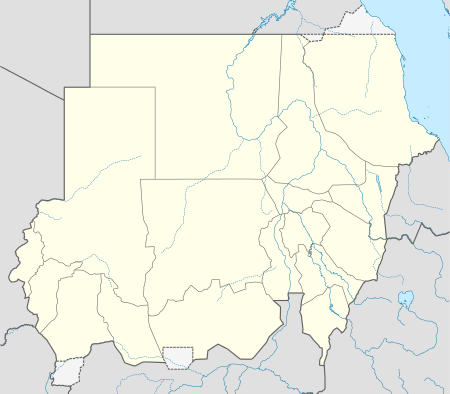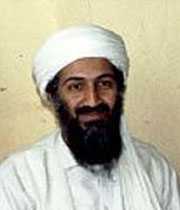Osama bin Laden's house in Khartoum
| Osama bin Laden's house in Khartoum | |
|---|---|
 | |
| General information | |
| Type | Compound |
| Architectural style | Stucco |
| Address | Al-Mashtal Street |
| Town or city | Al-Riyadh, Khartoum |
| Country | Sudan |
| Coordinates | 15°34′54″N 32°34′22″E / 15.58167°N 32.57278°E |
Osama bin Laden's house in Khartoum is a pink and beige brick-and-stucco three-storey house on Al-Mashtal Street in the affluent Al-Riyadh quarter of Khartoum, Sudan, where Osama bin Laden lived between 1991 and 1996.[1][2]
Background
Bin Laden arrived in Sudan in 1991 after falling out with Saudi Arabia's ruling family over their support for the United States in the Gulf War against Iraq. He purchased this property and another in Soba, a one storey unfurnished mud house on the western bank [3] overlooking the Blue Nile[4] where he spent many weekends with his family. He lived in Sudan with his four wives, four sons and daughter.[1][3] Although extremely wealthy, both houses were described as very modest on purpose to adhere to his ideals of humble living.[5] During his time in the country he heavily invested in the infrastructure and in agriculture and businesses. When he lived there he was more known as a "walking bank" than a successful organizer of terrorist operations.[6][7] Hassan al-Turabi allowed bin Laden to live in Sudan on the condition that he would invest in Sudan. It is estimated that he may have invested US $50 million in Sudan.[8] His investments consisted of a bank, trading firm and construction industry, all of these activities he managed with his nine-room office manned by veteran business men supported by 400 Sudanese men at a salary of $200 a month.[8]
Although the house was heavily guarded with guards armed with machine guns on the ground floor,[9] bin Laden once missed an assassination attempt at this house attempted by Takfiris, an ultra extremist group who considered bin Laden's ways as heretic. Following this attack, his house was made more secure with more guards and trenches dug in front and back of the house. This caused inconvenience to his neighbours who then wished that bin Laden would leave their neighbourhood.[9] After living in Sudan for more than 4 years, he left Sudan in May 1996, bitterly disappointed with political developments in the country he had invested so much in.[9][10] The property has remained vacant since bin Laden was expelled from the country in 1996 because tenants feared that the United States might bomb it.[2] However, it is also reported that China made it their Embassy.[9]
Description
Richard Miniter describes the house as follows:
"On El Meshtal Street, a visitor finds bin Laden's walled compound. The exterior walls are pink and faded to filth. The house is not the most opulent in this Sudanese version of Bel Air. It is a vaguely Art Deco affair, three stories high, with a ridge running up its front. Everything about the exterior of the house indicates comfort. An aluminium-frame walkway topped with thin wooden slats assures shade from the driveway to the front door. Air conditioners hum."[7]
The house was secured with a compound wall, painted pink but faded. At the sides of the house are a series of walled-in compounds.[7] This house was much more spacious and comfortable than the houses he lived in Afghanistan and Pakistan and bin Laden kept his office on second floor. He would even meet people in the open yard in front of his house.[7] He also owned guest houses across the street which he purchased as homes for his top officers.[7]
It is also said that bin Laden lived a very simple life. He owned no vehicles, and used no modern home appliances such as a refrigerator or air conditioner. He was reportedly also involved in experimental farming.[9] Today, the gate to bin Laden's old house is tightly shut, and the unkempt garden and wild tree branches growing over the wall stand out in such a wealthy, well-maintained part of the city.[2]
See also
References
- ↑ 1.0 1.1 Reeve, Simon (27 June 2002). The new jackals: Ramzi Yousef, Osama Bin Laden and the future of terrorism. UPNE. p. 172. ISBN 978-1-55553-509-4. Retrieved 7 May 2011.
- ↑ 2.0 2.1 2.2 "Bin Laden's Sudan home left empty over attack fears". Sudan.net, Reuters. Retrieved 7 May 2011.
- ↑ 3.0 3.1 Shay, Shaul; Liberman, Rachel (13 October 2006). The Red Sea terror triangle: Sudan, Somalia, Yemen, and Islamic terror. Transaction Publishers. p. 43. ISBN 978-1-4128-0620-6. Retrieved 7 May 2011.
- ↑ Reeve2002,p.175
- ↑ Landau, Elaine (1 January 2002). Osama bin Laden: a war against the West. Twenty-First Century Books. p. 58. ISBN 978-0-7613-1709-8. Retrieved 7 May 2011.
- ↑ Gallab, Abdullahi A. (2008). The first Islamist republic: development and disintegration of Islamism in the Sudan. Ashgate Publishing, Ltd. p. 127. ISBN 978-0-7546-7162-6. Retrieved 7 May 2011.
- ↑ 7.0 7.1 7.2 7.3 7.4 Miniter, Richard (25 September 2004). Losing Bin Laden: How Bill Clinton's Failures Unleashed Global Terror. Regnery Publishing. pp. 47–48. ISBN 978-0-89526-048-2. Retrieved 7 May 2011.
- ↑ 8.0 8.1 Mark Weston (11 July 2008). Prophets and princes: Saudi Arabia from Muhammad to the present. John Wiley and Sons. pp. 334–. ISBN 978-0-470-18257-4. Retrieved 8 May 2011.
- ↑ 9.0 9.1 9.2 9.3 9.4 Bergen, Peter L. (8 August 2006). The Osama Bin Laden I Know: An Oral History of Al Qaeda's Leader. Simon and Schuster. pp. 133–136. ISBN 978-0-7432-7892-8. Retrieved 7 May 2011.
- ↑ Jacquard, Roland (January 2002). In the name of Osama bin Laden: global terrorism & the bin Laden brotherhood. Duke University Press. p. 37. ISBN 978-0-8223-2991-6. Retrieved 7 May 2011.
External links
| ||||||||||||||||||||||||
